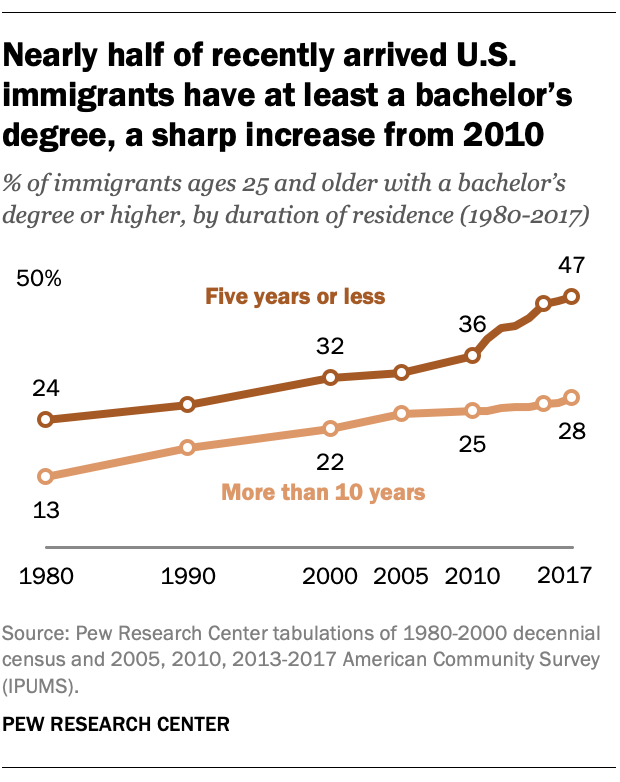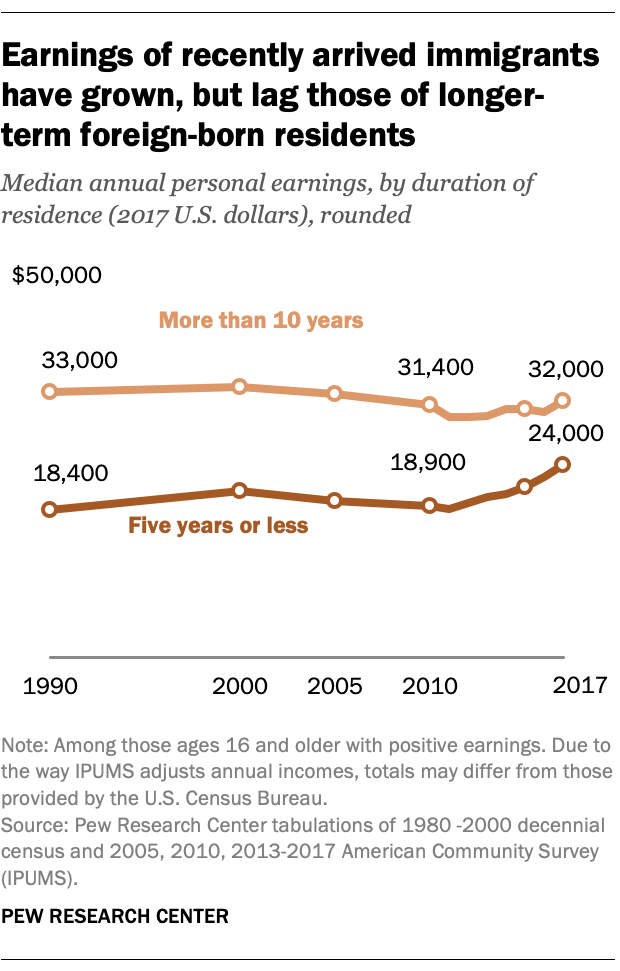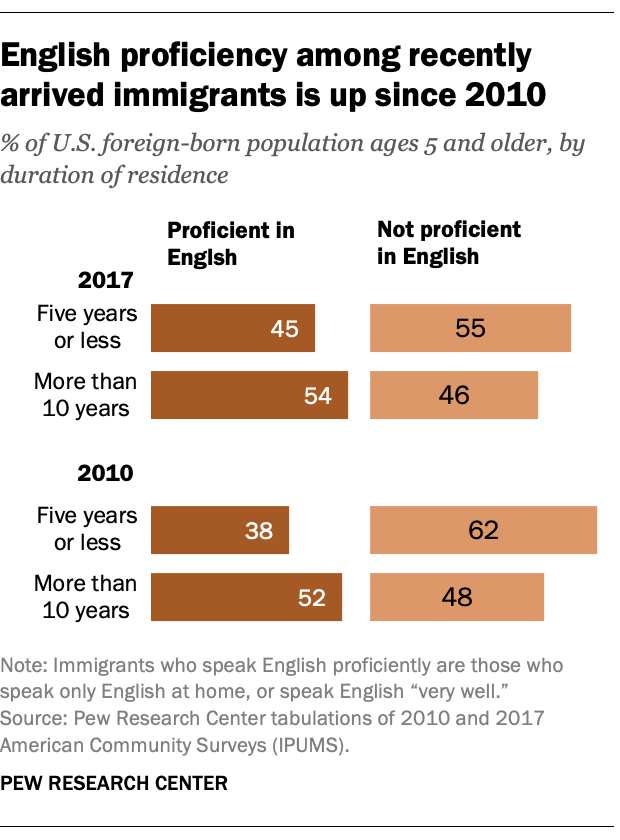 Recently arrived U.S. immigrants are a growing part of the nation’s foreign-born population, which reached a record 44.4 million in 2017. Overall, their profile differs from immigrants who have been in the country longer.
Recently arrived U.S. immigrants are a growing part of the nation’s foreign-born population, which reached a record 44.4 million in 2017. Overall, their profile differs from immigrants who have been in the country longer.
About 7.6 million immigrants have lived in the country for five years or less. They make up 17% of the foreign-born population, a share that has returned to 2010 levels after a slight dip. Recently arrived immigrants have markedly different education, income and other characteristics from those who have been in the U.S. for more than a decade. Proposed changes to U.S. immigration laws could favor highly skilled immigrants, which could further change the demographics of the nation’s foreign-born population. U.S. adults support encouraging highly skilled people to immigrate and work in the U.S., according to a 2018 survey from Pew Research Center.
[callout align=”alignright”]
View interactive charts and detailed tables on U.S. immigrants.
[/callout]Related: A statistical portrait of the nation’s foreign-born population, which includes historical trends since 1960
Here are several ways the differences between shorter- and longer-tenured U.S. immigrants have changed over time:
1 Short-term residents have more education than long-term residents, and the gap between these immigrant groups has widened. Almost half (47%) of immigrants ages 25 and older who arrived in the U.S. during the previous five years have a bachelor’s degree or more as of 2017, compared with just 28% of those who have lived in the country for more than 10 years. The share among newer arrivals has grown since 2010, when 36% had a college degree, compared with 25% of longer-tenured immigrants. Overall, the education levels of U.S. immigrants have increased, due in part to growing numbers of international students and highly skilled workers. By contrast, 32% of the U.S.-born population has a bachelor’s degree or higher.
Short-term residents have more education than long-term residents, and the gap between these immigrant groups has widened. Almost half (47%) of immigrants ages 25 and older who arrived in the U.S. during the previous five years have a bachelor’s degree or more as of 2017, compared with just 28% of those who have lived in the country for more than 10 years. The share among newer arrivals has grown since 2010, when 36% had a college degree, compared with 25% of longer-tenured immigrants. Overall, the education levels of U.S. immigrants have increased, due in part to growing numbers of international students and highly skilled workers. By contrast, 32% of the U.S.-born population has a bachelor’s degree or higher.
2Recently arrived immigrants have higher unemployment rates than longer-term immigrants. Immigrants who arrived in the past five years have a 7.1% unemployment rate, compared with a 3.9% unemployment rate for immigrants who have lived in the country for more than 10 years, according to Pew Research Center analysis of American Community Survey. Both groups have seen declines in unemployment since 2010, when their rates were 12.8% and 9.7%, respectively. More-recent arrivals have for decades had higher unemployment rates than longer-term residents, despite having more education. The opposite is true for the U.S. population overall: Those with more education have lower unemployment rates.
3 The personal earnings of recently arrived U.S. immigrants have increased, but trail those of longer-term immigrants. Those who arrived in the past five years had median annual personal earnings of $24,000 in 2017, compared with $32,000 among those who have lived in the country more than 10 years. For decades, more-recent arrivals have lagged longer-term residents in personal earnings despite having higher levels of education. For the U.S. population, by contrast, those with a college education have higher earnings. Since the Great Recession, the personal earnings of newer arrivals have increased while those of longer-tenured residents have remained flat.
The personal earnings of recently arrived U.S. immigrants have increased, but trail those of longer-term immigrants. Those who arrived in the past five years had median annual personal earnings of $24,000 in 2017, compared with $32,000 among those who have lived in the country more than 10 years. For decades, more-recent arrivals have lagged longer-term residents in personal earnings despite having higher levels of education. For the U.S. population, by contrast, those with a college education have higher earnings. Since the Great Recession, the personal earnings of newer arrivals have increased while those of longer-tenured residents have remained flat.
4 English proficiency among recently arrived immigrants is on the rise. Among those who arrived in the U.S. in the past five years, 45% said in 2017 that they either speak only English at home or speak English very well, up from 38% in 2010. Due to this increase, recent arrivals are closing the gap with longer-term immigrants, who have seen little change in their English proficiency. About half of immigrants who have lived in the U.S. for more than 10 years said in 2017 that they either speak only English at home or speak English very well, a share little changed from 2010.
English proficiency among recently arrived immigrants is on the rise. Among those who arrived in the U.S. in the past five years, 45% said in 2017 that they either speak only English at home or speak English very well, up from 38% in 2010. Due to this increase, recent arrivals are closing the gap with longer-term immigrants, who have seen little change in their English proficiency. About half of immigrants who have lived in the U.S. for more than 10 years said in 2017 that they either speak only English at home or speak English very well, a share little changed from 2010.
5South and East Asia is approaching Latin America and the Caribbean as the top origin region of recently arrived immigrants. Latin Americans account for 38% of U.S. immigrants who have arrived in the past five years, as of 2017, compared with 35% from Asia. This has changed since 2010, when immigrants from Latin America (48%) made up a far higher share of recent arrivals than Asia (30%).
Latin America and the Caribbean is by far the largest origin region among immigrants who have lived the country for more than 10 years. In 2017, immigrants from Latin America accounted for more than half (54%) of longer-term residents, compared with 25% among those from South and East Asia.




